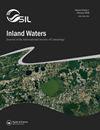DNA barcodes for Great Salt Lake brine flies establish a baseline for monitoring changes in biodiversity
IF 2.3
3区 环境科学与生态学
Q1 LIMNOLOGY
引用次数: 0
Abstract
ABSTRACT Great Salt Lake (GSL) is the center of a valuable wetland ecosystem in the Great Basin of North America. The lake is an important site for millions of migratory birds that feed on 2 principal invertebrates, brine shrimp and brine flies (Diptera: Ephydridae). Despite their ecological and economic importance, no genetic studies have been published for either resident GSL invertebrate. The family Ephydridae (shore flies and brine flies) is one of the largest in the order Diptera, with nearly 2000 described species. Members of this family are prominent in a variety of aquatic environments and are particularly interesting because of their adaptation to several marginal habitats, including hot springs, oil ponds, highly saline lakes, and inland alkaline pools and marshes. This report provides cytochrome c oxidase I (COI) DNA barcodes for 5 species of GSL shore flies, distributed among 5 genera and 3 subfamilies. The phylogenetic content of these DNA sequences is explored by comparing a molecular phylogeny to those based on morphological features. Over the past decade, urbanization and inflow diversion have reduced the surface area of GSL by nearly 50%, with unknown consequences for the ecosystem. This study establishes a genetic framework to assess changes in GSL invertebrate diversity important in monitoring the effects of anthropogenic and climate pressures on this important natural resource.大盐湖盐水蝇的DNA条形码为监测生物多样性变化建立了基线
大盐湖(Great Salt Lake, GSL)是北美大盆地珍贵湿地生态系统的中心。该湖是数百万候鸟的重要栖息地,这些候鸟以两种主要的无脊椎动物为食,卤虾和卤蝇(双翅目:卤蝇科)。尽管它们在生态和经济上具有重要意义,但没有发表过关于GSL无脊椎动物的遗传研究。蝇科(滨蝇和卤蝇)是双翅目中最大的一种,有近2000种已被描述。这个家族的成员在各种水生环境中都很突出,特别有趣的是,它们适应了几种边缘栖息地,包括温泉、油塘、高盐湖和内陆碱性水池和沼泽。本文提供了5种GSL岸蝇的细胞色素c氧化酶I (COI) DNA条形码,分布于3个亚科5属。这些DNA序列的系统发育内容是通过比较分子系统发育与基于形态特征的系统发育来探索的。在过去的十年中,城市化和流入分流使GSL的表面积减少了近50%,对生态系统的影响尚不清楚。本研究建立了一个遗传框架来评估GSL无脊椎动物多样性的变化,这对于监测人类活动和气候压力对这一重要自然资源的影响具有重要意义。
本文章由计算机程序翻译,如有差异,请以英文原文为准。
求助全文
约1分钟内获得全文
求助全文
来源期刊

Inland Waters
LIMNOLOGY-MARINE & FRESHWATER BIOLOGY
CiteScore
6.10
自引率
9.70%
发文量
34
审稿时长
>12 weeks
期刊介绍:
Inland Waters is the peer-reviewed, scholarly outlet for original papers that advance science within the framework of the International Society of Limnology (SIL). The journal promotes understanding of inland aquatic ecosystems and their management. Subject matter parallels the content of SIL Congresses, and submissions based on presentations are encouraged.
All aspects of physical, chemical, and biological limnology are appropriate, as are papers on applied and regional limnology. The journal also aims to publish articles resulting from plenary lectures presented at SIL Congresses and occasional synthesis articles, as well as issues dedicated to a particular theme, specific water body, or aquatic ecosystem in a geographical area. Publication in the journal is not restricted to SIL members.
 求助内容:
求助内容: 应助结果提醒方式:
应助结果提醒方式:


